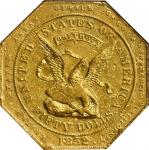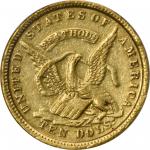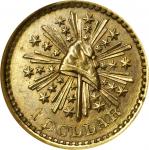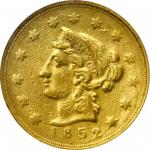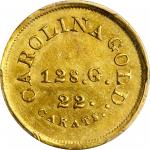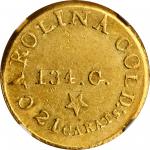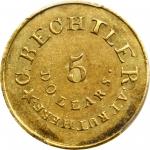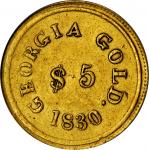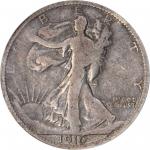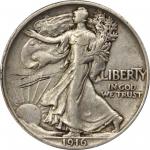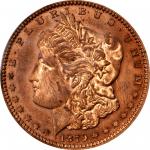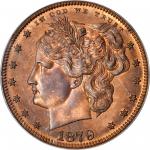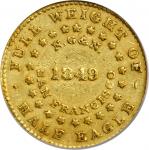1849 Norris, Gregg & Norris $5. K-3. Rarity-6. Reeded Edge. AU-50 (PCGS).Cast in a light yellow patina, the surfaces have an uncommonly smooth texture with only a few evenly scattered marks to betray its brief time spent in circulation in those heady dates of 49. The strike is even and well executed with all but even the very finest of details still readily apparent. A superior example from a truly historic California Gold Rush issue.Once word got out that gold had been found in Northern California, the rush was on at full gallop. Prospectors, pioneers, and fortune-seekers of all stripes arrived on the scene in 1848 and 1849 overwhelming the local economy almost immediately. Paper money was not trusted at all, any federally issued coin was whatever was brought in with the Forty-Niners, leaving only difficult to use and easily tainted gold dust to serve as a circulating medium. In short order, enterprising individuals set up assay offices and private coining facilities to help alleviate this situation. Widely believed to be the first of these private mints was established sometime in the spring of 1849 by partners Thomas H. Norris, Hiram A. Norris, and Charles Gregg in Benicia City. The first reference to any private mint in the local press uncovered so far came in the May 31, 1849 edition of the Daily Alta California, in which the editors noted a five-dollar gold coin struck at nearby Benicia City that, In general appearance it resembles the United States coin of the same value, but it bears the private stamp of Norris, Grieg [sic] & Norris, and is in other particulars widely different. Despite the indication that the coin closely resembled the federally issued half eagle, in actually the Norris, Gregg, & Norris $5 coin was nothing of the sort. Other than a single ring of small stars, the obverse of the coin is almost purely inscriptional, while the reverse has an eagle with drooping wings completely unlike the Gobrecht half eagle. Throughout its brief existence, Norris, Gregg, & Norris only struck $5 coins in four varieties, with plain and reeded edges, as well as with or without a period after the word ALLOY. The K-3 variety with reeded edge and no period, as here, is the scarcest of the four. The coins seem to have found quick acceptance and while some brokers understandably cautious with privately issued gold coins questioned the pieces, Mint assays by Jacob R. Eckfeldt and William E. DuBois substantiated their purity. Sometime in 1850, Norris, Gregg & Norris established a branch in Stockton and struck 1850-dated $5 coins marked STOCKTON and is known from a unique specimen permanently impounded in the Smithsonian collection. Norris, Gregg & Norris faded into history with no indication of when they ceased operations; references to the coins in local papers had ceased by 1851. The companys output does not appear to have been large suggesting a fairly limited mintage. Today, all varieties of Norris, Gregg, & Norris $5 pieces are quite rare and eagerly pursued by pioneer gold specialists. Like many other territorial issues from the period, the majority of the issue are funded in the middle circulated grade levels, becoming progressively scarcer in the finer grades. A delectable example from the very beginning of private coinage in Gold Rush California.From the Dr. Andrew Mitchell Collection.


